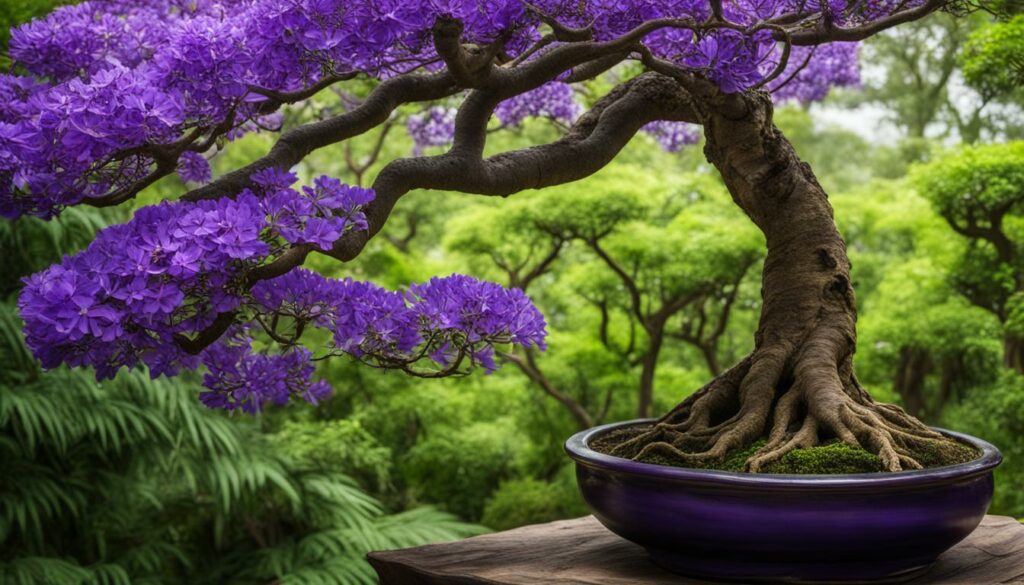If you’re looking for an exotic bonsai species to add to your collection, consider the Jacaranda bonsai. This tropical bonsai tree species stands out for its stunningly vibrant purple flowers and delicate foliage. But cultivating and maintaining this species requires specialized knowledge and care. In this article, we will provide you with all the information you need to know about growing and caring for Jacaranda bonsai trees.
Key Takeaways
- The Jacaranda bonsai is a tropical bonsai tree species with stunning purple flowers.
- Cultivating a Jacaranda bonsai requires specialized knowledge and care.
- Proper lighting, temperature control, and soil mixtures are key to growing and maintaining healthy Jacaranda bonsai trees.
- Pruning and shaping techniques can help create aesthetically pleasing Jacaranda bonsai trees.
- Managing pests and diseases is crucial to sustaining flowering in Jacaranda bonsai trees.
Introduction to the Jacaranda Bonsai
As a bonsai enthusiast, you may have heard of the Jacaranda bonsai, a miniature version of the renowned Jacaranda trees. This tropical bonsai species has gained popularity among bonsai enthusiasts due to its unique and exotic allure. In this section, we will explore the history and origins of the Jacaranda bonsai, as well as the reasons why it has become an appealing choice for bonsai artists.
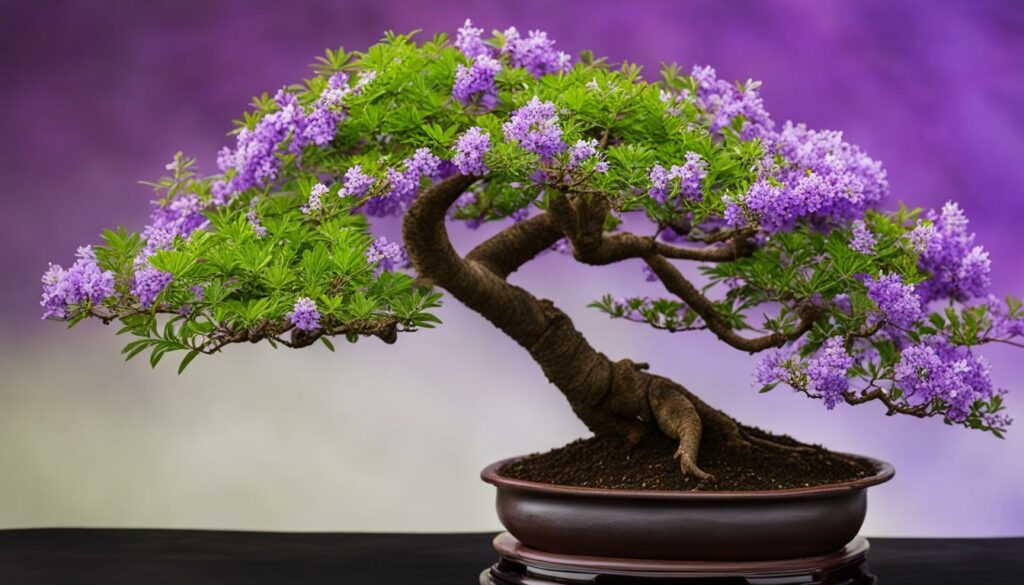
The Origins of the Jacaranda Bonsai
| Location | Climate | Soil |
|---|---|---|
| South America | Tropical | Well-draining |
The Jacaranda bonsai is native to South America, where it is often grown as a shade tree in tropical climates. The bonsai version was first developed in Japan, where it gained popularity due to its delicate foliage and stunning purple flowers.
“The Jacaranda bonsai is an excellent choice for those looking to add a touch of tropical beauty to their bonsai collection.”
Why the Jacaranda Bonsai is Popular Among Bonsai Enthusiasts
- Vibrant, purple flowers
- Unique foliage and overall growth patterns
- Suitable for indoor and outdoor environments
- Relatively easy to care for
The Jacaranda bonsai has a unique visual appeal, with its vibrant purple flowers and delicate foliage. It is also a hardy tree that can be grown indoors or outdoors, making it a flexible option for bonsai artists of all levels. Additionally, it is relatively easy to care for and can thrive in a variety of soil mixtures and growing conditions.
Now that you have an idea of what sets the Jacaranda bonsai apart, let’s dive into what makes this bonsai species unique in terms of its characteristics.
Characteristics of the Jacaranda Bonsai
As a tropical bonsai, the Jacaranda tree boasts some unique characteristics that set it apart from other varieties. One of the most notable features is its delicate foliage that consists of fern-like leaves. This makes the Jacaranda bonsai a striking addition to any indoor or outdoor space.
In addition to the foliage, the Jacaranda bonsai is renowned for its stunning purple flowers. These beautiful blooms add vibrant pops of color to your space and are sure to catch the eye of anyone passing by. The flowering season typically starts in the spring or summer months when temperatures are warmer, making it the perfect time to showcase your tree.
The Jacaranda bonsai’s growth pattern is another distinguishing characteristic. This tree tends to grow fairly quickly, so it’s important to stay on top of pruning and shaping to maintain a desirable shape. With proper care and attention, the Jacaranda bonsai can reach up to two feet in height and spread up to three feet.
“The Jacaranda bonsai’s delicate foliage and stunning purple flowers make it a dramatic showpiece in any collection.”
This tropical bonsai thrives in warm, humid environments, making it an ideal choice for those living in warmer climates. When grown indoors, it’s best to provide ample sunlight and a consistent temperature to ensure its optimal growth.
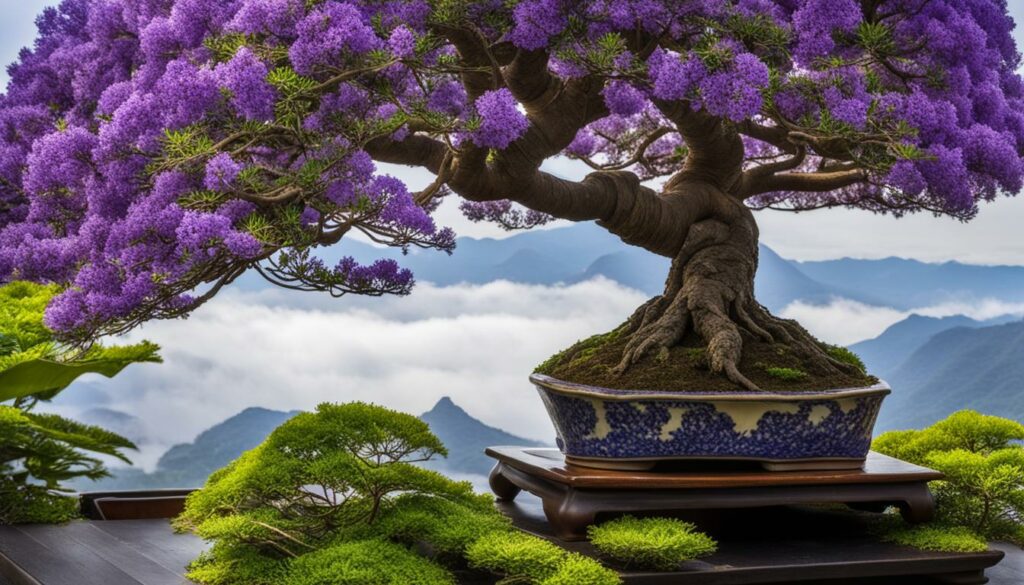
Jacaranda Bonsai Characteristics Table
| Characteristics | Description |
|---|---|
| Foliage | Delicate, fern-like leaves |
| Flowers | Stunning purple blooms |
| Growth Pattern | Fairly quick growth, reaching up to 2 feet tall and 3 feet wide |
| Environment | Thrives in warm, humid environments; requires ample sunlight for indoor growth |
In summary, the Jacaranda bonsai’s foliage, flowers, growth pattern, and environmental needs make it a highly desirable addition to any bonsai collection. With proper care and attention, you can showcase the beauty and uniqueness of this tropical bonsai species.
Cultivating the Jacaranda Bonsai
Successfully cultivating the Jacaranda bonsai requires careful attention to its specific needs. Below are some essential requirements for creating a healthy environment that allows your tropical bonsai tree to thrive:
Ideal Growing Conditions
The Jacaranda bonsai thrives in warm, humid conditions. It prefers temperatures between 65°F to 75°F during the day and between 55°F to 65°F at night. When selecting a location for your bonsai tree, ensure it receives bright and indirect sunlight. Low light conditions may affect its growth and flowering potential.
Tip: Place your Jacaranda bonsai in an east-facing window for optimal sunlight exposure.
Soil Mixture
The right soil mixture is critical for the success of your Jacaranda bonsai. It should be a well-draining soil with a balanced mix of organic and inorganic materials. You can make your soil mixture by combining Akadama, pumice, and lava rock in a 3:1:1 ratio.
Watering Techniques
The Jacaranda bonsai requires frequent watering to maintain healthy growth. Water your bonsai tree when the soil feels slightly dry to the touch. Make sure to water the entire soil surface and avoid letting it dry out completely, as this may damage the roots.
Tip: Use a watering can with a long spout to water your Jacaranda bonsai without disrupting the soil or damaging the leaves.
Fertilization
Applying the right fertilizer is crucial to encourage blooming in your Jacaranda bonsai. Fertilize your bonsai tree every two weeks during the growing season using a balanced liquid fertilizer. Avoid fertilizing during the dormant season as this may cause damage to the roots.
Tip: Switch to a high-phosphorus fertilizer to promote blooming in your Jacaranda bonsai before you expect flowers to appear.
| Jacaranda Bonsai Cultivation Tips |
|---|
| Place your Jacaranda bonsai in bright, indirect light and avoid low light conditions. |
| Use a well-draining soil mix to ensure proper moisture levels for your bonsai tree. |
| Water your Jacaranda bonsai frequently, but avoid letting it dry out completely. |
| Fertilize your bonsai tree regularly during the growing season to encourage blooming. |
Note: Be patient when growing your Jacaranda bonsai, as it may take several years before it reaches its full blooming potential.
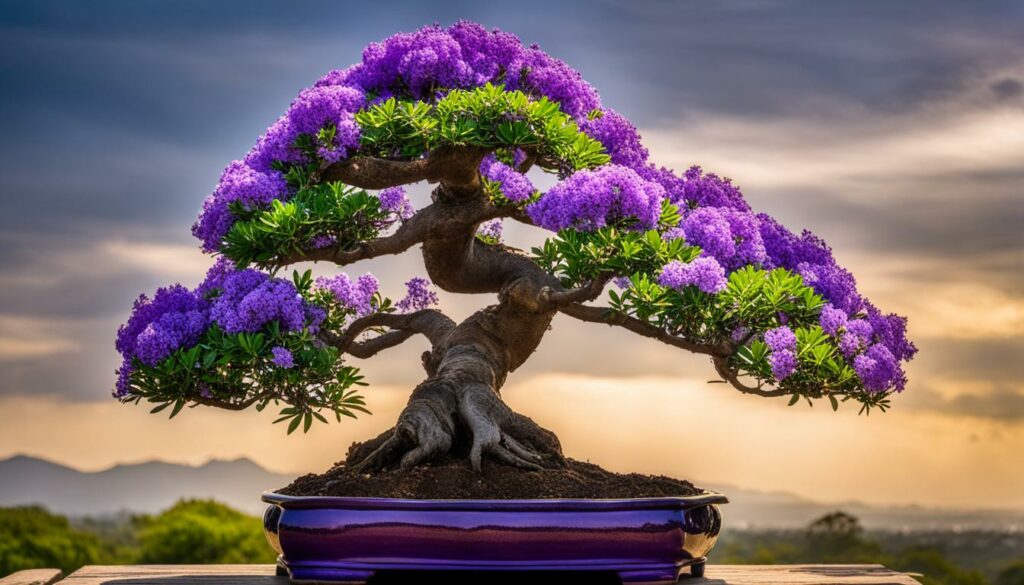
Pruning and Shaping the Jacaranda Bonsai
The key to developing a beautiful and well-formed Jacaranda bonsai lies in proper pruning and shaping. By using various techniques, you can create stunning aesthetics for your tropical bonsai.
Branch Selection
When selecting branches for your Jacaranda bonsai, look for those that are healthy, well-placed, and have good potential for future growth. Remove weak or damaged branches to redirect energy to more productive areas.
Wiring
Wiring is an essential technique for shaping the branches of your Jacaranda bonsai tree. Use thin, flexible wires to bend and position branches in desired directions. Be careful not to apply too much pressure or damage the bark, as this can harm the tree.
Regular Maintenance
Regular pruning and trimming are essential for maintaining the health and shape of your Jacaranda bonsai. Remove any dead, diseased, or damaged branches to prevent the spread of infection. Additionally, trim back any overgrown foliage to maintain a well-balanced appearance.
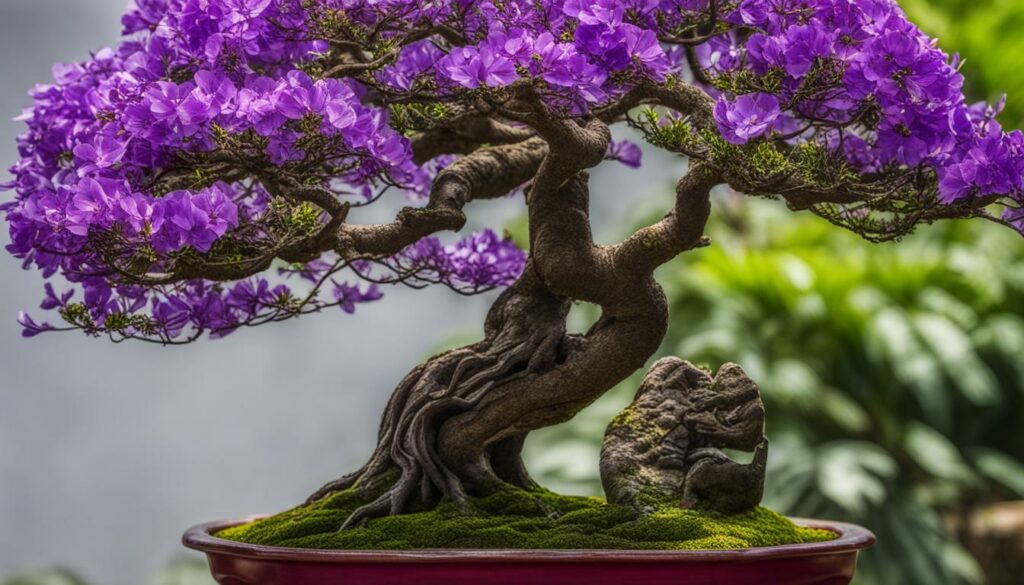
Remember to carefully monitor the health of your Jacaranda bonsai tree during the pruning process, and always take steps to promote its overall health and wellbeing.
Sustaining Flowering in the Jacaranda Bonsai
Once you have successfully grown your Jacaranda bonsai, the next step is to ensure that it continues to bloom vibrantly. Proper care is essential to sustain flowering in this tropical bonsai species.
Firstly, provide your bonsai with adequate light exposure. Jacaranda bonsais thrive in bright, indirect light, ideally by a north-facing window or under grow lights if natural light is insufficient.
Secondly, regulate the temperature around your bonsai. Keep it in a warm area with temperatures ranging from 65-85°F (18-29°C) and avoid exposing it to sudden temperature fluctuations or cold drafts.
Thirdly, water your Jacaranda bonsai regularly and avoid overwatering or underwatering. The soil should be damp to the touch, but not soggy or dry. Additionally, fertilize your bonsai every two weeks during the growing season, from spring to fall, using a balanced liquid fertilizer.
Lastly, protect your Jacaranda bonsai from pests and diseases that can hinder its flowering. Inspect it regularly for signs of mites, aphids, mealybugs, and other pests, and treat with an appropriate pesticide if necessary. Furthermore, observe good bonsai hygiene to prevent the spread of fungal or bacterial diseases.
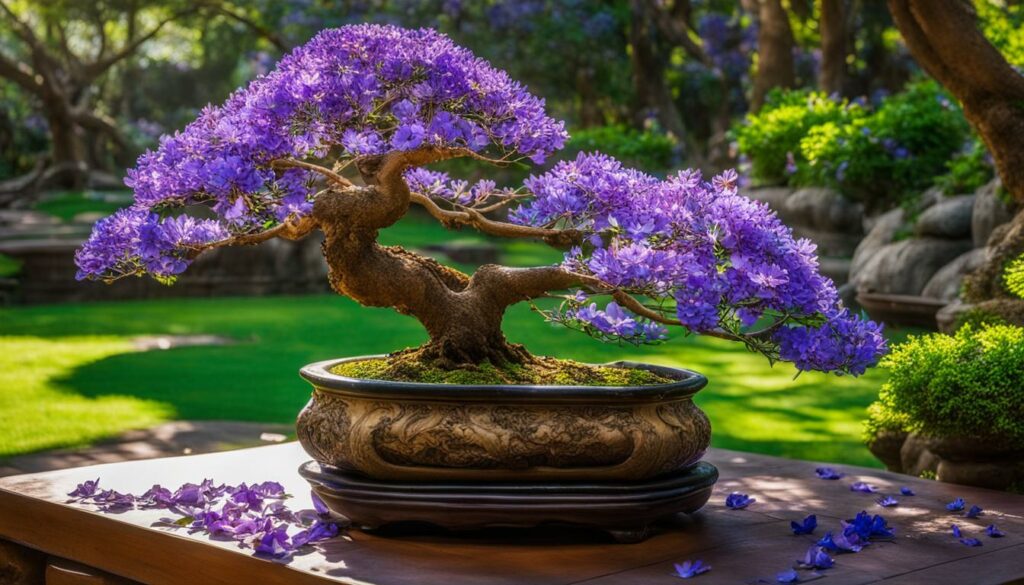
Maintaining proper light exposure, temperature regulation, watering, fertilization, and pest management techniques are the keys to sustaining the flowering beauty of your Jacaranda bonsai. With these tips, your bonsai will continue to bloom vibrantly and enchant all who behold its mesmerizing allure.
Jacaranda Bonsai Display and Styling
Once you have cultivated a healthy and beautiful Jacaranda bonsai, it’s time to showcase it with unique and creative display options. The Jacaranda bonsai is a tropical bonsai that can add a unique touch to any indoor or outdoor setting. Below are some display and styling ideas to help you enhance the overall aesthetic appeal of your miniature tree.
Traditional Bonsai Pots
The most popular way to display your Jacaranda bonsai is in a traditional bonsai pot. These pots are specially designed to accommodate bonsai trees and come in different sizes, shapes, and colors. Consider a pot that complements the colors of the Jacaranda’s flowers and foliage. A glazed ceramic pot with a bright blue finish can add a striking contrast to the dark purple flowers of the Jacaranda bonsai.
Companion Plants
Pairing your Jacaranda bonsai with companion plants can create a stunning visual display. Choose plants that thrive in the same growing conditions as your Jacaranda bonsai, such as other tropical plants like ti plants and bromeliads. Placing small accent plants around the base of your bonsai can also add depth and interest to your display.
Tip: When selecting companion plants for your Jacaranda bonsai, consider plants that complement the purple flowers and delicate foliage of your bonsai tree. Look for plants with contrasting leaf textures and shapes to add interest and create visual balance.
Bonsai Display Stands
Bonsai display stands provide a unique and beautiful way to showcase your Jacaranda bonsai. These stands come in a range of styles and finishes, from simple pine wood stands to elaborate carved wooden designs. Choose a display stand that accentuates the natural elegance of your bonsai tree.
Seasonal Displays
Displaying your Jacaranda bonsai in different seasonal settings can add variety and interest to your display. During the holiday season, consider adding miniature lights and ornaments to your bonsai tree for a festive touch. In the spring, surround your bonsai with colorful flowers such as daisies or tulips to create a vibrant and cheerful display.
Tabletop Displays
Jacaranda bonsai is perfect for adding a touch of nature to your indoor decor. Create a beautiful tabletop display by placing your bonsai tree on a tray with river rocks, sand, or moss. Add small decorative elements like miniature lanterns or figurines for a whimsical touch.
With these creative ideas for displaying and styling your Jacaranda bonsai, you can create a stunning visual display that showcases the unique beauty of this tropical bonsai species.
Troubleshooting Common Issues with the Jacaranda Bonsai
While the Jacaranda bonsai is a relatively low-maintenance tree, it is not immune to common issues that can affect bonsai trees. Here are some troubleshooting tips to help you maintain the health of your bonsai:
Yellowing Leaves
If you notice your Jacaranda bonsai’s leaves turning yellow, it may be a sign of overwatering or poor drainage. Check the soil for moisture content and adjust watering accordingly. Make sure the pot has adequate drainage holes to prevent water from pooling around the roots.
Root Problems
Root rot is a common problem in Jacaranda bonsai trees caused by overwatering or poor drainage. If you suspect root rot, gently remove the tree from the pot and examine the roots for discoloration or mushiness. Trim away any damaged roots and repot the tree in fresh soil with improved drainage.
Pests and Diseases
Common pests that can affect Jacaranda bonsai trees include spider mites and mealybugs. You can control these pests by regularly inspecting the tree and removing any affected branches or leaves. For more severe infestations, use an insecticidal soap or oil. Also, monitor your tree for signs of disease, such as leaf spotting or discoloration, and promptly treat as needed.
Note: If you encounter any other issues with your Jacaranda bonsai that you are unsure how to address, consult a bonsai specialist or reputable online forum for further guidance.
Conclusion
Overall, growing the Jacaranda bonsai can be a rewarding experience for bonsai enthusiasts. This tropical bonsai species is known for its vibrant flowering allure, delicate foliage, and unique growth patterns that make it a prized addition to any bonsai collection. By following the care tips discussed in this article, you can create a healthy environment for your bonsai tree to thrive, sustain its flowering, and maintain its overall health and beauty. Remember to regularly prune and shape your Jacaranda bonsai to create stunning aesthetics and experiment with different display and styling options to enhance its overall appeal.
FAQ
What is a Jacaranda bonsai?
A Jacaranda bonsai is a miniature version of the Jacaranda tree, which is known for its vibrant purple flowers. It is a tropical bonsai species that is cherished for its flowering allure.
Where can I find a Jacaranda bonsai?
You can find Jacaranda bonsai trees at specialized bonsai nurseries or through online bonsai retailers. Ensure that you purchase from reputable sources to guarantee the quality of the tree.
How do I care for a Jacaranda bonsai?
To care for a Jacaranda bonsai, you should provide it with a sunny location that receives partial shade. It requires regular watering, as the soil should never dry out completely. Fertilize the bonsai during the growing season, and protect it from extreme temperatures.
When does the Jacaranda bonsai bloom?
The Jacaranda bonsai typically blooms during the spring and early summer months. Its stunning purple flowers add a touch of exotic beauty to the bonsai tree.
Can I shape the Jacaranda bonsai using pruning techniques?
Yes, you can shape the Jacaranda bonsai using pruning techniques. Regular pruning helps maintain the shape and size of the tree, as well as encourages new growth. However, be cautious not to remove too much foliage at once, as it can stress the bonsai.
What are the ideal conditions for growing a Jacaranda bonsai?
A Jacaranda bonsai thrives in tropical or subtropical environments. It requires warm temperatures, adequate sunlight, and high humidity levels to flourish. Growing it indoors or in a greenhouse can provide the necessary conditions.
How often should I water my Jacaranda bonsai?
The frequency of watering a Jacaranda bonsai depends on various factors such as temperature, humidity, and the size of the bonsai pot. As a general guideline, check the moisture level of the soil regularly and water when the top inch feels slightly dry.
Can I keep my Jacaranda bonsai indoors?
While it is possible to keep a Jacaranda bonsai indoors, it requires a sunny location with adequate light. Supplemental grow lights may be necessary, especially during the winter months when natural light is limited. Ensure good air circulation and monitor humidity levels to prevent issues.
How do I fertilize my Jacaranda bonsai?
Fertilize your Jacaranda bonsai during the growing season using a balanced bonsai fertilizer. Follow the packaging instructions for the appropriate dosage and frequency. Avoid over-fertilization, as it can damage the roots of the bonsai tree.
What are common pests and diseases that affect Jacaranda bonsai?
Common pests that can affect Jacaranda bonsai include aphids, mealybugs, and scale insects. Diseases such as root rot, powdery mildew, and fungal infections can also occur. Regular inspection and proper care can help prevent and address these issues.
